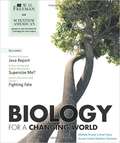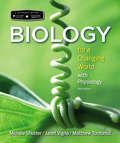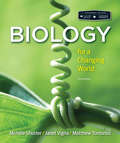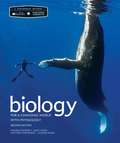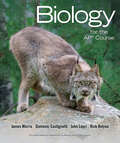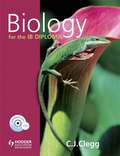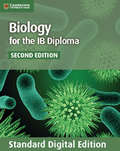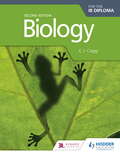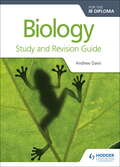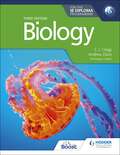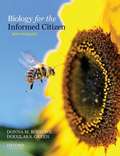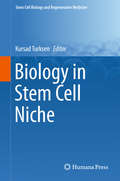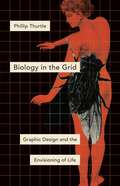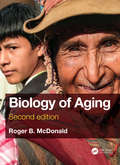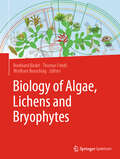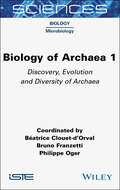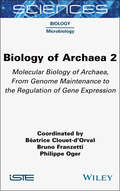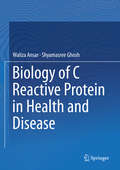- Table View
- List View
Biology for a Changing World
by Michele Shuster Janet Vigna Gunjan Sinha Matthew TontonozBiology for a Changing World is supported by a robust set of study and teaching resources and products. These support materials have been written by a team of experienced non-majors educators and are tied together by peer-reviewed Learning Objectives for each chapter. These objectives allow instructors to identify the core concepts that most challenge their students and enable them to target student needs earlier and more effectively.
Biology for a Changing World
by Janet Vigna Matthew Tontonoz Michèle ShusterFrom the groundbreaking partnership of Macmillan Learning and Scientific American comes this one-of-a-kind introduction to the science of biology and its impact on the way we live. In Biology for a Changing World, two experienced educators and a science journalist explore the core ideas of biology through chapters written and illustrated in the style of a Scientific American article. Chapters don't just feature compelling stories of real people--each chapter is a newsworthy story that serves as a context for covering the standard curriculum for the non-majors biology course. Updated throughout, the new edition offers new stories, enhanced plant and diversity coverage, and an expanded media program. Biology for a Changing World is supported by its own dedicated version of LaunchPad--Macmillan's breakthrough online course space which fully integrates an interactive e-Book, all student media, a wide range of assessment and course management feature.
Biology for a Changing World
by Janet Vigna Matthew Tontonoz Michèle ShusterFrom the groundbreaking partnership of W. H. Freeman and Scientific American comes this one-of-a-kind introduction to the science of biology and its impact on the way we live. In Biology for a Changing World, two experienced educators and a science journalist explore the core ideas of biology through a series of chapters written and illustrated in the style of a Scientific American article. Chapters don't just feature compelling stories of real people--each chapter is a newsworthy story that serves as a context for covering the standard curriculum for the non-majors biology course. Updated throughout, the new edition offers new stories, additional physiology chapters, a new electronic Instructor's Guide, and new pedagogy.
Biology for a Changing World with Physiology (Second Edition)
by Michele Shuster Janet Vigna Gunjan Sinha Matthew TontonozExplores the core ideas of biology through a series of chapters written and illustrated in the style of a Scientific American article. Each chapter is a newsworthy story that serves as a context for covering the standard curriculum for the non-majors biology course. Updated throughout, the new edition offers new stories, additional physiology chapters, a new Electronic Teachers’ Edition, and new pedagogy.
Biology for the AP® Course
by James Morris Rick Relyea John Lepri Domenic CastignettiExplore Biology for the AP® Course, a textbook program designed expressly for AP® teachers and students by veteran AP® educators. Biology for the AP® Course provides content organized into modules aligned to the CED, AP® skill-building instruction and practice, stunning visuals, and much more.
Biology for the Health Sciences: Mechanisms of Disease
by Mark F WiserBiology is central to our understanding of health and disease and to the development of effective treatments, and thus it is critical that health professionals have a solid grounding and knowledge comfort in the pathogenesis and mechanisms of disease processes. This innovative new textbook draws these topics together, providing an accessible introduction across four central disciplines - basic biology, biotechnology, non-infectious disease and infectious disease. Key Features: Provides students of biology and those going into health care professions with a strong foundation to understand the pathogenesis of disease at the molecular and cellular level Focuses on the etiology and pathophysiology of the major human diseases by body system, including diabetes and nutritional disorders, cardiovascular disease, neurodegenerative diseases, and cancer, aligned to medicine and health science course structure Covers mechanisms of infectious disease transmission, as well as disease pathophysiology, and considers the impact of antibiotic resistance Reviews the applications of biotechnology and genomics to human health in diagnosis and treatment, as well as to our understanding of disease and disease surveillance Each chapter contains a mini glossary of key terms and associated definitions, and review questions allow students to assess how much of the chapter they have understood Digital resources accompany the textbook, such as interactive quizzes for students to engage with and figure slides of the book's illustrations that instructors can use in lectures Enhanced throughout with plentiful illustrations, Biology for the Health Sciences is an essential companion for any student of the health sciences and for biological science students studying the causes of disease as part of a wider course.
Biology for the IB Diploma
by C. J. Clegg<p>Written specially for students following the International Baccalaureate (IB) Diploma, IB Diploma Biology is a major new textbook covering the latest syllabus requirements for this experimental science. <p>Chapters are presented in syllabus order and their content reflects the necessary coverage of all core Topics and Options for students at both Standard and Higher levels. Throughout, the processes of science and something of its history are introduced selectively to illustrate the possibilities and limitations of science. <p> <li>Chapters open with a list of 'Starting points' that summarise essential concepts. <li>Topics and Options coverage accurately reflects the Objectives and Action Verbs in which syllabus assessment statements are phrased. <li>Material for Standard level and Higher level is clearly identified. <li>Text is written in straightforward language with key terms simply defined, and examples are drawn from a wide range of international sources. <li>Main sections specify the syllabus sub-topic being addressed, making links between the text and syllabus content self-evident. <li>Photographs, electron micrographs and full-colour illustrations complement the text, and illustrate principles and processes in context. <li>Self-assessment questions and typical exam questions aid comprehension and familiarise students with the syllabus requirements, improving exam performance. <li>Links to Theory of Knowledge provide opportunities for cross-curriculum study. <li>Extension boxes broaden information beyond the core requirements. <li>Includes a chapter on the integration of theory with practicals and projects and their presentation for Internal Assessment, written by a guest author, Gary Seston, an experienced IB teacher and examiner. <li>The glossary provides an invaluable reference for students.</li></p>
Biology for the IB Diploma (IB Diploma Series)
by Brenda WalpoleBiology for the IB Diploma, Second edition covers in full the requirements of the IB syllabus for Biology for first examination in 2016. The second edition of this well-received Coursebook is fullly updated for the IB Biology syllabus for first examination in 2016, comprehensively covering all requirements. Get the best coverage of the syllabus with clear assessment statements, and links to Theory of Knowledge, International-mindedness and Nature of Science themes. Exam preparation is supported with plenty of sample exam questions, online test questions and exam tips. Chapters covering the Options and Nature of Science, assessment guidance and answers to questions are included in the free online material available with the book.
Biology for the IB Diploma Second Edition
by Andrew Davis C. J. CleggProvide clear guidance to the 2014 changes and ensure in-depth study with accessible content, directly mapped to the new syllabus and approach to learning.This second edition of the highly regarded textbook contains all SL and HL content, which is clearly identified throughout. Options are available free online, along with appendices and data and statistics.- Improve exam performance, with exam-style questions, including from past papers- Integrate Theory of Knowledge into your lessons and provide opportunities for cross-curriculum study- Stretch more able students with extension activities- The shift to concept-based approach to learning , Nature of Science, is covered by providing a framework for the course with points for discussion - Key skills and experiments included
Biology for the IB Diploma Second Edition
by C. J. CleggProvide clear guidance to the 2014 changes and ensure in-depth study with accessible content, directly mapped to the new syllabus and approach to learning.This second edition of the highly regarded textbook contains all SL and HL content, which is clearly identified throughout. Options are available free online, along with appendices and data and statistics.- Improve exam performance, with exam-style questions, including from past papers- Integrate Theory of Knowledge into your lessons and provide opportunities for cross-curriculum study- Stretch more able students with extension activities- The shift to concept-based approach to learning , Nature of Science, is covered by providing a framework for the course with points for discussion - Key skills and experiments included
Biology for the IB Diploma Study and Revision Guide
by Andrew Davis C. J. CleggStretch your students to achieve their best grade with these year round course companions; providing clear and concise explanations of all syllabus requirements and topics, and practice questions to support and strengthen learning. - Consolidate revision and support learning with a range of exam practice questions and concise and accessible revision notes- Practise exam technique with tips and trusted guidance from examiners on how to tackle questions- Focus revision with key terms and definitions listed for each topic/sub topic
Biology for the IB Diploma Study and Revision Guide
by Andrew Davis C. J. CleggExam Board: IBLevel: IBSubject: BiologyFirst Teaching: September 2014First Exam: Summer 16Stretch your students to achieve their best grade with these year round course companions; providing clear and concise explanations of all syllabus requirements and topics, and practice questions to support and strengthen learning. - Consolidate revision and support learning with a range of exam practice questions and concise and accessible revision notes- Practise exam technique with tips and trusted guidance from examiners on how to tackle questions- Focus revision with key terms and definitions listed for each topic/sub topic
Biology for the IB Diploma Third edition
by Andrew Davis C. J. CleggDeveloped in cooperation with the International Baccalaureate®Trust experienced and best-selling authors to navigate the new syllabuses confidently with these coursebooks that implement inquiry-based and conceptually-focused teaching and learning.- Ensure a continuum approach to concept-based learning through active student inquiry; our authors are not only IB Diploma experienced teachers but are also experienced in teaching the IB MYP and have collaborated on our popular MYP by Concept series. - Build the skills and techniques covered in the Tools (Experimental techniques, Technology and Mathematics) with direct links to the relevant parts of the syllabus; these skills also provide the foundation for practical work and internal assessment.- Integrate Theory of Knowledge into your lessons with TOK boxes and Inquiries that provide real-world examples, case studies and questions. The TOK links are written by the author of our bestselling TOK coursebook, John Sprague and Paul Morris, our MYP by Concept series and Physics co-author.- Develop approaches to learning with ATL skills identified and developed with a range of engaging activities with real-world applications. - Explore ethical debates and how scientists work in the 21st century with Nature of Science boxes throughout. - Help build international mindedness by exploring how the exchange of information and ideas across national boundaries has been essential to the progress of science and illustrates the international aspects of science. - Consolidate skills and improve exam performance with short and simple knowledge-checking questions, exam-style questions, and hints to help avoid common mistakes.
Biology for the IB Diploma Third edition
by Andrew Davis C. J. CleggDeveloped in cooperation with the International Baccalaureate®Trust experienced and best-selling authors to navigate the new syllabuses confidently with these coursebooks that implement inquiry-based and conceptually-focused teaching and learning.- Ensure a continuum approach to concept-based learning through active student inquiry; our authors are not only IB Diploma experienced teachers but are also experienced in teaching the IB MYP and have collaborated on our popular MYP by Concept series. - Build the skills and techniques covered in the Tools (Experimental techniques, Technology and Mathematics) with direct links to the relevant parts of the syllabus; these skills also provide the foundation for practical work and internal assessment.- Integrate Theory of Knowledge into your lessons with TOK boxes and Inquiries that provide real-world examples, case studies and questions. The TOK links are written by the author of our bestselling TOK coursebook, John Sprague and Paul Morris, our MYP by Concept series and Physics co-author.- Develop approaches to learning with ATL skills identified and developed with a range of engaging activities with real-world applications. - Explore ethical debates and how scientists work in the 21st century with Nature of Science boxes throughout. - Help build international mindedness by exploring how the exchange of information and ideas across national boundaries has been essential to the progress of science and illustrates the international aspects of science. - Consolidate skills and improve exam performance with short and simple knowledge-checking questions, exam-style questions, and hints to help avoid common mistakes.
Biology for the IB MYP 4 & 5: By Concept
by Andrew Davis Patricia DeoEndorsed by the IBDrive meaningful inquiry through a unique concept-driven narrative.- Supports every aspect of assessment with opportunities that use the criteria- Gives you easy ways to differentiate and extend learning- Provides a meaningful approach by integrating the inquiry statement in a global context- Develops critical-thinking skills with activities and summative sections rooted in the ATL frameworkThis title is also available in two digital formats via Dynamic Learning. Find out more by clicking on the links at the top of the page.
Biology for the IB MYP 4 & 5: By Concept (MYP By Concept)
by Andrew Davis Patricia DeoThe only series for MYP 4 and 5 developed in cooperation with the International Baccalaureate (IB)Develop your skills to become an inquiring learner; ensure you navigate the MYP framework with confidence using a concept-driven and assessment-focused approach presented in global contexts.- Develop conceptual understanding with key MYP concepts and related concepts at the heart of each chapter.- Learn by asking questions with a statement of inquiry in each chapter. - Prepare for every aspect of assessment using support and tasks designed by experienced educators.- Understand how to extend your learning through research projects and interdisciplinary opportunities.This title is also available in two digital formats via Dynamic Learning. Find out more by clicking on the links at the top of the page.
Biology for the Informed Citizen with Physiology
by Donna M. Bozzone Douglas S. GreenWith Biology for the Informed Citizen, students connect the concepts of biology to the consequences of biology. Authors Donna M. Bozzone and Douglas S. Green teach the concepts of biology, evolution, and the process of science so that students can apply their knowledge as informed consumers and users of scientific information. <p><p> Cases: An engaging biological issue opens every chapter and is revisited throughout <p> Concepts: Foundational biological ideas are introduced within the context of important cultural and social issues <p> Consequences: The concepts and consequences of biology are connected in order to help students make informed decisions about biological issues
Biology in Stem Cell Niche: Methods And Protocols (Stem Cell Biology and Regenerative Medicine #1035)
by Kursad TurksenThis comprehensive volume explores functions, pathologies, and applications of stem cells in relation to the niches in which they develop. Ten chapters cover the subject in depth, from a historical perspective through signaling, hormonal control, quiescence, biomimetics, epigenetics, engineering strategies for emulating, tumorigenesis and more. The chapter authors represent a broad range of international expertise and perspectives. This installment of the popular Stem Cell Biology and Regenerative Medicine series delivers authoritative, international perspectives on this rapidly growing field. Biology of Stem Cell Niche is an ideal complementary volume to Tissue-Specific Stem Cell Niche and Adult Stem Cells, Second Edition and will be invaluable to clinicians and researchers working with stem cells as well as to postgraduate trainees who are studying them.
Biology in the Grid: Graphic Design and the Envisioning of Life (Posthumanities)
by Phillip ThurtleHow grids paved the way for our biological understanding of organisms As one of the most visual sciences, biology has an aesthetic dimension that lends force and persuasion to scientific arguments: how things are arranged on a page, how texts are interspersed with images, and how images are composed reflect deep-seated beliefs about how life exists on Earth. Biology in the Grid traces how our current understanding of life and genetics emerged from the pervasive nineteenth- and twentieth-century graphic form of the grid, which allowed disparate pieces of information to form what media theorist Vilém Flusser called &“technical images.&”Phillip Thurtle explains how the grid came to dominate biology in the twentieth century, transforming biologists&’ beliefs about how organisms were constructed. He demonstrates how this shift in our understanding of biological grids enabled new philosophies in endeavors such as advertising, entertainment, and even political theory. The implications of the arguments in Biology in the Grid are profound, touching on matters as fundamental as desire, our understanding of our bodies, and our view of how society is composed. Moreover, Thurtle&’s beautifully written, tightly focused arguments allow readers to apply his claims to new disciplines and systems. Bristling with insight and potential, Biology in the Grid ultimately suggests that such a grid-organized understanding of natural life inevitably has social and political dimensions, with society recognized as being made of interchangeable, regulated parts rather than as an organic whole.
Biology of Aging
by Roger B. McDonaldBiology of Aging, Second Edition presents the biological principles that have led to a new understanding of the causes of aging and describes how these basic principles help one to understand the human experience of biological aging, longevity, and age-related disease. Intended for undergraduate biology students, it describes how the rate of biological aging is measured; explores the mechanisms underlying cellular aging; discusses the genetic pathways that affect longevity in various organisms; outlines the normal age-related changes and the functional decline that occurs in physiological systems over the lifespan; and considers the implications of modulating the rate of aging and longevity. The book also includes end-of-chapter discussion questions to help students assess their knowledge of the material. Roger McDonald received his Ph.D. from the University of Southern California and is Professor Emeritus in the Department of Nutrition at the University of California, Davis. Dr. McDonald’s research focused on mechanisms of cellular aging and the interaction between nutrition and aging. His research addressed two key topics in the field: the relationship between dietary restriction and lifespan, and the effect of aging on circadian rhythms and hypothalamic regulation. You can contact Dr. McDonald at rbmcdonald@ucdavis.edu. Related Titles Ahmad, S. I., ed. Aging: Exploring a Complex Phenomenon (ISBN 978-1-1381-9697-1) Moody, H. R. & J. Sasser. Gerontology: The Basics (ISBN 978-1-1387-7582-4) Timiras, P. S. Physiological Basis of Aging and Geriatrics (ISBN 978-0-8493-7305-3)
Biology of Algae, Lichens and Bryophytes
by Wolfram Beyschlag Burkhard Büdel Thomas FriedlAs a reader of this book you will become familiar with current, up-to-date comprehensive knowledge about all classes of eukaryotic algae, the cyanobacteria, and symbiotic interactions of algae and cyanobacteria with other organisms. For example, the lichens are symbiotic consortia and a prominent example of a particularly successful ‘evolution by cooperation’. We expand even to the beginnings of terrestrial plant life and the bryophytes, which are gradually transmitting to the vascular plants. We collectively call this enormous phylogenetic wealth of photoautotrophic organisms the ‘new cryptogams’, abandoning the traditional definition of cryptogams. The new cryptogams are all those autotrophic organisms that share being hydro-passive, meaning that they are unable of controlling water uptake or release, in contrast to vascular plants. While being basal of and phylogenetically much more diverse than the vascular plants, the new cryptogams are ecologically highly relevant in all ecosystems of our Planet. They are responsible for more than half of the Earth’s annual oxygen production.
Biology of Archaea, Volume 1: Discovery, Evolution and Diversity of Archaea (ISTE Invoiced)
by Béatrice Clouet-d'Orval Bruno Franzetti Philippe OgerArchaea constitute a new branch of life alongside bacteria and eukaryotes. These microorganisms are unique in their cellular and molecular aspects. They have evolutionary links with the first eukaryotic cells and are now being used to elucidate fundamental biological questions. Champions of extremophilicity, archaea are helping to lift the veil on the limits of life on Earth. Biology of Archaea 1 explores the discovery and evolution of the field of archaea research. This book also looks at the evolutionary history of archaea and their integration into the tree of life, and examines this complex and extremely diverse world in terms of their ecological niches and their still largely unexplored virosphere.
Biology of Archaea, Volume 2: Molecular Biology of Archaea, From Genome Maintenance to the Regulation of Gene Expression (ISTE Invoiced)
by Béatrice Clouet-d'Orval Bruno Franzetti Philippe OgerArchaea constitute a new branch of life alongside bacteria and eukaryotes. These microorganisms are unique in their cellular and molecular aspects. They have evolutionary links with the first eukaryotic cells and are now being used to elucidate fundamental biological questions. Champions of extremophilicity, archaea are helping to lift the veil on the limits of life on Earth. Biology of Archaea 2 presents the diverse molecular mechanisms involved in the fundamental processes of genome maintenance and regulation of gene expression in archaeal cells. This book analyzes the complex machinery involved in chromosome replication, DNA repair, RNA synthesis (transcription) and protein synthesis (translation), and explores the different classes of RNAs and enzymes involved in RNA maturation and degradation. These regulate the stability of messenger and regulatory non-coding RNAs, and contribute to the formation of the mature forms of ribosomal RNAs and transfer RNAs. These molecular mechanisms are closely related to those of eukaryotes.
Biology of Bats
by William A. WimsattBats had mastered flight eons before man's own lineage began. Their unique volitional mode was obviously advantageous, for adaptive radiation within the group has been little short of extraordinary. Today Chiroptera represent the second largest order of mammals in number of species and the largest in overall abundance; excluding man, and possibly rodents, they are also the most widely distributed land-based mammals.
Biology of C Reactive Protein in Health and Disease
by Waliza Ansar Shyamasree GhoshThis book offers a comprehensive study of C-reactive protein (CRP) belonging to the pentraxin family, including a brief history of CRP, its structure, synthesis and evolution. Focusing on the emerging role of CRP and its clinical application in the field of disease biology, it details the pathophysiological role of CRP in a host of diseases such as cardiovascular disease, diabetes, cancers, rheumatoid arthritis and infectious diseases and others. It also discusses the role of innate immunity and acute phase response (APR) and their key mediators in the host body in response to tissue injury, infection, trauma or surgery, immunological disorders or neoplastic growth. CRP's significance in inflammation is highlighted, and its importance as a clinical marker in cardiovascular disease, its functional significance in Leishmania and Plasmodium infections, its association with the development of insulin resistance in type 2 diabetes mellitus, and its role in cancer are discussed in detail. The book also includes clinical data studies and presents the latest research advances to further readers' understanding of CRP.
